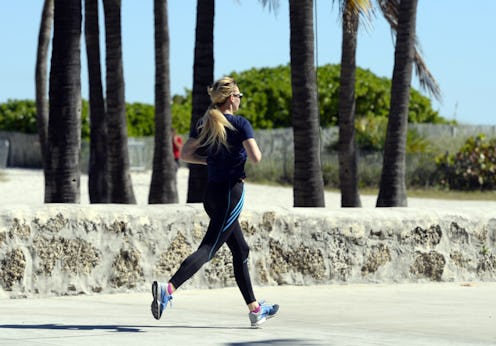Life
9 Ways to Run Faster
Looking to break a new personal record in your next race? Or just want to work your way up from a walk to a jog? Running faster during your workouts takes dedication, time, and the ability to break out of the norm—you just have to be willing to get a little uncomfortable. It's not as bad as it sounds, though!
Learning to run faster can be fun when you experiment with sprints, resisted harness runs, or sled pulls—all great drills that feature facets of speed training, says Yusuf Jeffers, an instructor at Tone House NYC. Although it may not make sense, all runners can actually benefit from doing workouts besides running. Exercises that address other performance components, including strength, speed, flexibility, coordination, and endurance, says Jeffers.
Deborah Warner, founder and owner of the Mile High Run Club also suggests trail running or track workouts to break up any monotony in your training.
We all go through running ruts, where it’s difficult to pass a far-reaching goal, but the moment you run through that threshold is when you'll see the results happen. It could be a small leap or big bound, but it’s a step in the right direction.
Learn to pick up the speed and attack your running goals with these 9 drills and tips:
1. Get lean
Leaning out your body fat will help pave the way for muscle gain, which helps propel you forward during a race. A body composition test can tell you the percentage of body fat you currently have, and can be done at most gyms or training facilities. From there, choose healthier foods and run and cross-train regularly—when you’re leaner, you run faster, says Warner.
2. Mobility training
Stretching your muscles pre- and post-workout is still debatable, but most experts agree that adding mobility to your weekly routine will help improve overall running performance. “Repetitive motion will cause tightness, which can affect performance,” says Warner. "Increase mobility by foam rolling, doing yoga, and stretching, which can allow for optimal sprint mechanics," says Jeffers. “Runners with impaired flexibility limit their potential to develop speed," he says.
3. High knees
High knees help improve running form and coordination. The movement of going up with your knees paired with fast propelling to the ground allows your foot to scoop and push off of the ground. Spring up with light feet into each high knee to add speed and swing your arms straightforward and fast to improve your running form.
4. Sprints
Sprint workouts alternate between low and high intensity speeds, helping to build endurance and increase your pace. Plus, there are so many sprint workouts to choose from that it’s fun to make it your own. Fartlek (a funny Swedish word that means “speed play”) workouts are an alternating series of jogging and sprints, that help prepare a runner for uneven paces throughout a race. They can be done at the beginning, middle, or end of a run at whatever speeds you choose. Longer sprint workouts can include 200m, 400m, or 800m repeats on a track, allowing yourself only a small window of recovery in between each sprint. This helps increase running stamina.
5. Ladder drills
Ladder runs are an agility exercise to help increase the speed and balance of your feet. Using a long rope ladder placed along the ground, alternate your feet in and out of each ring while running as fast as you can through the length of ladder.
6. Resistance-harness running
Don't be scared by the name of this drill—they're challenging, but fun! Resistance-harness running can help add power and intensity to your training regimen. “They inherently load and place the body into positions that mimic ideal sprint mechanics and require increased endurance,” says Jeffers. "It helps teach you to keep pushing and driving your feet forward and can help improve your running form." Resistance-harness running can be done with a partner, a weight, or a parachute.
7. Hill repeats
Most race courses have at least one hill or gradual elevation that can often slow you down. (Womp, womp.) Find a big hill at your local park and do a series of hill repeats at a pace slightly faster than your race pace. Running hills build muscle and strength that help power your knees, legs, butt, and core muscles as you push up the incline. And the best part about hills? You get to fly down the other side!
8. Increase mileage
Once you’ve gotten a steady baseline built up, add distance little-by-little to improve endurance and stamina, which will help strengthen your body for faster, more powerful runs. “Increase overall weekly mileage with about one-third total miles executed at a higher intensity,” said Warner.
9. Shuttle runs
No, this does not mean a bus will "shuttle" you to the end of your run (wishful thinking, though!). Shuttle runs are similar to sprints, but focus on even shorter bouts of power running that range from 10m, 20m, and 30m—or even combinations of all three distances. Start by setting up markers on both sides of the distance you choose, then sprint from one to the next and then back again, leaning down and touching the markers on each side. Repeat these shuttle drills to improve acceleration, balance, speed, and anaerobic fitness.
Images: Getty Images (2)/Giphy (2)/KBandsTraining
